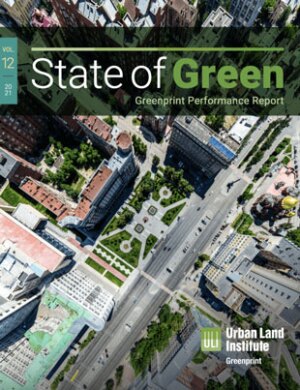ULI Greenprint Center for Building Performance’s annual report found a 12.4 percent reduction in carbon emissions in 2020 compared with an average 3.5 percent fall in previous years. In addition, the report found that real estate owners took advantage of reduced occupancy during the pandemic to double the implementation of energy efficiency projects.
The annual report, benchmarking 11,991 properties in 30 countries, shows the impact of COVID-19 on building performance. Reductions were much larger than previous years, likely due to lower utilization of properties: carbon dioxide emissions were down 12.4 percent, water consumption down 8.1 percent, energy consumption down 12.5 percent, electricity use down 12.4 percent, natural gas use down 8.9 percent, and landfill waste down 11.7 percent.
With many office and retail assets largely unoccupied, the number of ESG projects implemented increased significantly. In 2020, members reported a total of 14,793 projects. Highlights included:
- Boston Properties achieved enterprise-level Fitwel Viral Response certification and developed a Health Security Plan, focusing on air and water quality, physical distancing, cleaning, pandemic-ready provisions, and communications
- Prologis completed construction on its Netherlands Eindhoven DC4 warehouse, a highly efficient property that produces more renewable energy than it consumes
- NEO achieved net zero carbon operations by procuring 100 percent renewable geothermal power through its utility at no cost premium
Investment in ESG projects was more than matched by a quadrupling of building certifications in 2020, mainly in industrial, office and residential properties. LEED remained the most common holistic sustainability certification in the U.S., while BREEAM accounted for most new certifications in Europe and NABERS the majority in Asia Pacific. Health and wellbeing-focused certifications also increased, with over three times the number of Fitwel certifications achieved in 2020.
A new goal to achieve net zero carbon operations by 2050 was signed up to by a core of 17 Greenprint members, representing over $570 billion in assets under management and over 3,300 properties. Greenprint members made the biggest strides toward net zero by acquiring utility-provided green power and buying renewable energy certificates. The report endorses building electrification as a means of achieving a fully renewable-powered building, despite the potential to increase energy consumption in the short term.
Smaller reductions reported from on-site renewables reflects current challenges of on-site power generation and the significant potential for utilities and off-site power purchase agreements to meet demand for low-carbon electricity. On-site solar nonetheless remains a high-priority renewable energy investment strategy for Greenprint members. Of the 70 carbon-related ESG projects reported in 2020, 50 focused on solar.
Marta Schantz, senior vice president at ULI Greenprint Center for Building Performance, commented, “The remaining years of this decade are critically important for keeping global warming below 1.5 degrees Celsius. Global emissions dipped briefly during the pandemic, but rebounded quickly. There’s no complacency among the most responsible owners, investors and developers. Greenprint members took the opportunity of lower occupancy levels to conduct energy efficiency retrofits and up their game on energy efficiency.”
The Greenprint members’ new net zero goal uses the World Green Building Council’s definition of net zero, which is a portfolio that is highly energy efficient and fully powered by on-site or off-site renewables, and is based on CDP scope 1 and 2 greenhouse gas emissions and direct operational control (excluding occupant operations). Greenprint members can choose to go beyond scope 1 and 2 to include occupant operations. Greenprint recognizes that carbon emissions from tenant energy use and from embodied carbon from building materials must also be reduced over time.
The full report is available on Knowledge Finder.
ULI Greenprint is hosting a webinar on September 15 at 1pm EDT to explore the report’s projects, findings, and implications for real estate. Register Now





